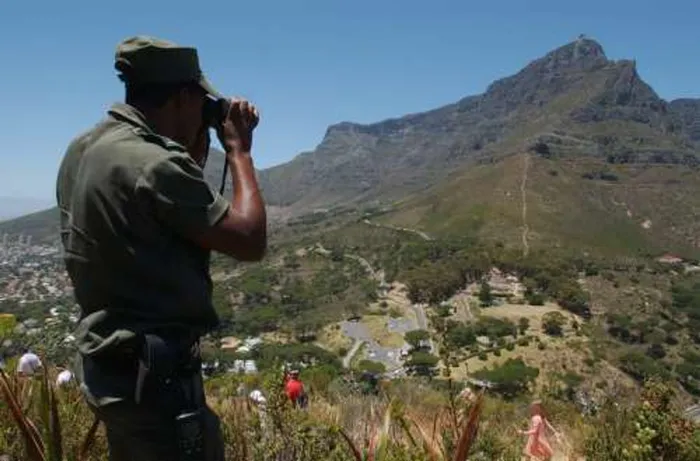Easter eggs on Africa Ledge

The notices are explicit: "Warning: extremely dangerous route with steep rock climbing and difficult navigation. Do not attempt this route if inexperienced. Use at own risk."
India Venster offers some spectacular views of both the city bowl and, higher up, the Camps Bay coastline. It is also a route that includes a number of steep scrambles and is used frequently by climbers and experienced mountain hikers to access Africa Ledge.
The notices aren't there for fun - if you aren't used to clambering and don't have a head for heights, this isn't the route for you.
Easter Sunday dawned with a bright blue sky and a stiff south-easterly breeze. There was cloud forming over Constantiaberg as I headed towards town, my only company a near full moon dipping towards the western horizon. I was gambling that the front face of Table Mountain would be clear, but I had already packed the rain jacket just in case.
Driving past the burned vegetation of Mowbray Ridge and Vredehoek there was little traffic, and parking on Tafelberg Road wasn't a problem. However, the cable car was apparently closed due to high winds and that meant that I would have to walk back down, doubling the distance and physical demands of the hike.
Visitors need to remember you can never guarantee the cableway will be operating, so it is wise to have a back-up plan.
It is equally wise to carry a cellphone, water, sunblock and hat and some warm clothes. Good shoes are a must, as is a guidebook or map; things can change up there fast and that romantic-looking tablecloth can become a killer if you find yourself in the middle of it.
The route up India Venster is a favourite and, although generally I take the traverse across Arrow Face, this time the intention was to turn the corner over Camps Bay and cross the Tabletop before descending Platteklip Gorge. It makes for a boring slog back to the car, but it is the best and safest option and has an easily navigated escape route if things change.
As I walked, I could hear a boisterous group of the Tatwoc climbing group (don't ask what the name means, but you can find them on Google) behind me. Contrary to popular belief, these are the real "bergies" of Cape Town. They have fun, drink tea (by all accounts, lots of it), regard Africa Ledge as pretty much their private domain and climb on the mountain hard and often. It meant that if there was a problem, I had guys with ropes, gear and more cellphones behind me.
That wasn't too much of a concern for me, but I could see on the path a man and his son, who didn't appear prepared for what lay ahead. The lack of a pack and the single water bottle in the pocket indicated that they didn't know what lay between them and the upper cable station - and there was a good chance that it still wasn't running. This situation frequently occurs on the mountain; it can prove fatal - and has done so in the past with alarming frequency.
It turned out these visitors from Durban had somehow managed to miss the signage and really didn't have any idea what was coming. In the end I chose to chaperone them up the route, assisting where necessary on the steeper clambers and ensuring they didn't miss any crucial turns.
In fact, they were great company - fit and intelligent people who had made an error of judgment. We had a wonderful walk. The exercise is always welcome, and you simply cannot but give thanks for the magnificence of our city when you see it from up there. The grime, all too apparent at ground level, is lost to perspective and you are left with one magnificent vista after another.
At Africa Ledge the Tatwoc climbers caught up and we were invited to join them for a spot of tea. The Durbanites were offered the very best of Cape hospitality - tea, biscuits, Easter eggs and incredible views. We eventually carried on around the route and to the top. By the time we got there, the cableway was running and we were able to avoid the slog down - a good thing in that, for all my preparation, my shoes were losing their soles and were likely to hamper the descent.
With two other deaths on this route only recently, obviously something needs to change. Personally I am not keen on turning our mountain into a jungle gym, with ladders and chains bespoiling the wilderness.
On the other hand, is it reasonable to expect people to take any notice of the signage?
The consensus among climbers seems to be to put a limited number of wide hand/foot-holds on the more risky sections, which would prevent the inexperienced from inadvertently getting themselves into trouble. Trying to close down the path isn't really a workable option and would certainly result in opposition from regular users.
I have always felt that if people want to be stupid about the mountain, that's their problem.
But my unplanned companions on this hike convinced me that sometimes, perfectly intelligent people simply make an error of judgment, which could in fact be their last.
Special thanks to Robert, Charles, Tienie, Tony, Kevin and Dylan for adding tea and Easter eggs to the pleasure of the walk.
And thanks to whatever gods made sure we all arrived safely back at sea level.